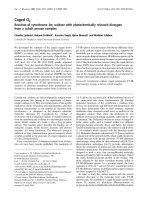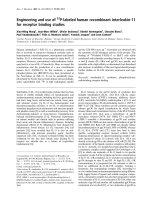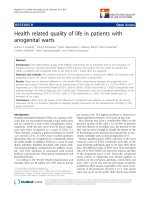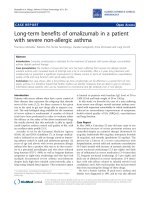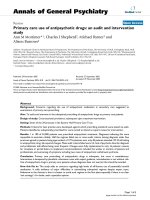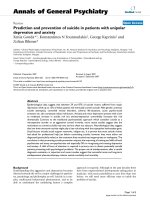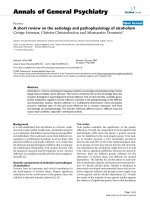Báo cáo y học: "A rational use of glucocorticoids in patients with early arthritis has a minimal impact on bone mass" ppt
Bạn đang xem bản rút gọn của tài liệu. Xem và tải ngay bản đầy đủ của tài liệu tại đây (439.11 KB, 9 trang )
RESEARC H ARTIC LE Open Access
A rational use of glucocorticoids in patients
with early arthritis has a minimal impact on
bone mass
Monica Ibañez
1
, Ana M Ortiz
2
, Isabel Castrejón
2
, J Alberto García-Vadillo
2
, Inmaculada Carvajal
3
, Santos Castañeda
2
,
Isidoro González-Álvaro
2*
Abstract
Introduction: Glucocorticoid (GC)-induced osteoporosis is a frequent complication in patients with rheumatoid
arthritis. However, little information exists about the consequences of GC use in patients with early arthritis. Here
we describe the variables underlying the use of GC in early arthritis, as well as its effect on bone-mineral density.
Methods: Data from 116 patients in our early arthritis register were analyzed (90 women; median age, 52.5 years,
interquartile range (IQR, 38.5-66); 6-month median disease duration at entry (IQR, 4-9)). In this register, the clinical
and treatment information was recorded systematically, including the cumulative GC dose. Lumbar spine, hip, and
forearm bone-mineral density (BMD) measurements were performed at entry and after a 2-year follow-up.
A multivariate analysis was performed to establish the variables associated with the use of GCs, as well
as those associated with variations in BMD.
Results: Of the patients with early arthritis studied, 67% received GCs during the 2-year follow-up. GCs were more
frequently prescribed to elderly patients, those with higher basal disease activity and disability, and patients with
positive rheumatoid factor. When adjusted for these variables, GCs were less frequently prescribed to female
patients. The use of GCs was associated with an increase of BMD in the ultradistal region of the forearm, although
it induced a significant loss of BMD in the medial region of the forearm. No relevant effect of GC was noted on
the BMD measured at other locations.
Conclusions: The frequent use of GCs as a “bridge therapy” in patients with early arthritis does not seem to be
associated with relevant loss of bone mass. Moreover, cumulative GC administration might be associated with an
increase of juxtaarticular BMD.
Introduction
Rheumatoid arthritis (RA) is a systemic and chronic
inflammatory disease that has been associated with dis-
ability, the existence of comorbidities, and decreased life
expectancy [1,2]. The use of glucocorticoids (GCs) to
treat RA offers rapid antiinflammatory effects and the
capacity to arrest radiologic progression [3-6]. However,
long-term GC use may cause multiple adverse events,
even at low doses [7,8]. Therefore, an individual evalua-
tion is required to establish the best risk/benefit ratio
for their prescription [9,10].
One of the most striking side effects of this drug is
GC-induced osteoporosis (GIOP), a complication in
patients with RA that can be prevented [11-13]. The
prevalence of OP in RA pa tients is higher than that in
the normal population, ranging from 20% to 37%
[14,15], although this figure increases to almost 50%
among postmenopausal women after long-term steroid
use [16]. However, establishing the real contribution of
GCs to OP in RA is challenging because bone mineral
loss is of multifactorial origin in these patients, and it
may be influenced by inflammatory cytokines, inactivity,
GCs, disease-modifyin g antirheumatic drugs (DMARDs),
as well as the classic risk factors for OP.
* Correspondence:
2
Rheumatology Department, Hospital Universitario de La Princesa, Diego de
León 62, Madrid, 28006, Spain
Ibañez et al. Arthritis Research & Therapy 2010, 12:R50
/>© 2010 Monica Ibañe z et al.; licensee BioMed Central Ltd. This is an open access article distributed under the terms of the Creative
Commons Attribution License (http://cre ativecommons.org/licenses/by/ 2.0), which permits unrestricted use, distribution, and
reproduction in any medium, provided the original work is properly cited.
Despite the different studies focusing on OP, little
information is available regarding the use of GCs in
patients with early arthritis. Nevertheless, it has been
suggested that using GC in these patients does not
affect bone mass, as has been observed in the long-term
disease, probably because controlling inflammatory
activity at early stages may prevent bone loss [17-19].
The aim of this study was to analyze the patterns of
GC use and the reasons for its use in a population of
early arthritis patients. In addition, we studied the
impact of different factors on the evolution of mineral
bone content in these patients, including GC use.
Materials and methods
Patients and study design
We studied 116 patients who attended our Early Arthri-
tis Clinic from July 2002 to April 2008. Patients were
referred to the clinic if they had two or more swollen
joints for ≥ 4 weeks and symptoms for <1 year. Patients
were excluded if diagnosed with gouty arthritis, septic
arthritis, spondyloarthropathies, or connective tissue dis-
eases during the follow-up period. In addition, we
excluded patients with primary hyperparat hyroidism and
other metabolic bone disorders other than OP. At the
end of the follow-up period, 78 patients fulfilled the
ACR 1987 criteria for RA classification [20], and 38
patients were classified as having undifferentiated arthri-
tis (UA). The characteristics of the patients are shown
in Table 1. The study protocol was reviewed and
approved by the Local Research Ethics Committee, and
all the patients who entered the study signed a written
consent form after being informed about the details of
the protocol.
The study includes data from patients followed up
over a pe riod of 2 years and who were evaluated at four
visits during this period. The following data were col-
lected and entered into an electronic database: clinical
and demographic information, incl uding the 28 tender
and swollen joint counts (TJCs and SJCs, respectively);
global disease assessment by patient (GDAP ) and physi-
cian (GDAPh) on a 100-mm visual analogue scale; and
basic laboratory tests including erythrocyte sedimenta-
tion rate (ESR), C-reactive protein (CRP), rheumatoid
factor (RF: by nephelometry; positive if >20 IU/ml), and
serum antibodies directed against cyclic citrullinated
peptide (anti-CCP: ELISA, Euro-Diagnostica Immunos-
can RA; positive at >50 IU/ml). The four-component
disease-activity score based on 28-joint counts and ESR
(DAS28) was calculated as described previously [21].
The patients also completed the validated Spanish ver-
sion of the Health Assessment Questio nnaire (HAQ) to
assess functional ability [22].
Comorbidity of other medical conditions was evalu-
ated during the follow-up period, including that o f
hyperte nsion, diabetes mellitus, and thyroid dysfunction.
Other known factors that affect bone mass were also
Table 1 Baseline population characteristics
Total (n = 116) RA (n = 78) UA (n = 38) P
Age 52.5 [38.5-65.6] 51.6 [43.0-66.7] 53.5 [34.0-64.5] NS
Female gender, n (%) 90 (77.6) 63 (80.7) 27 (71.1) NS
Disease duration (mo) 6.1 [4.2-9.1] 5.6 [4.0-8.4] 6.75 [4.5-9.8] NS
HAQ 1.0 [0.5-1.5] 1.1 [0.5-1.6] 0.8 [0.5-1.3] NS
DAS28 3.9 [3.2-5.2] 4.5 [3.6-5.8] 3.3 [2.8-4.6] 0.001
Rheumatoid factor, n (%) 45 (38.8) 38 (48.7) 7 (18.4) 0.002
Anti-CCP, n (%) 39 (33.6) 36 (46.1) 3 (7.9) <0.001
Comorbidities: n (%)
Hypertension 35 (30.2) 22 (28.2) 13 (34.2) NS
Diabetes mellitus 13 (11.2) 8 (10.2) 5 (13.2) NS
Thyroid dysfunction 17 (14.6) 15 (19.2) 2 (5.2) 0.1
Menopause (% of women) 58 59 56 NS
Age at menopause (years) 50 [44-52] 48 [44-50] 52 [50-53] 0.017
Calcium intake
(rare/moderate/high), (%)
15/62/23 14/65/21 16/58/26 NS
Smoking n (%) 28 (24.1) 19 (24.4) 9 (23.7) NS
Exercise (rare/moderate/intense) (%) 38/47/15 42/42/16 29/58/13 NS
Body mass index (kg/m
2
) 26.5 [24.5-30.5] 26.0 [24.0-30.0] 28.0 [26.0-30.9] NS
Prior personal fractures (%) 17 18 16 NS
Prior family fractures (%) 19 18 24 NS
Data are shown as the percentage of patients or as the median and interquartile range.
Abbreviations: anti-CCP, antibodies directed to cyclic citrullinated peptide; DAS28, disease activity score in 28 joints; HAQ, health assessment questionnaire; NS,
not statistically significant; RA, rheumatoid arthritis; UA, undifferentiated arthritis.
Ibañez et al. Arthritis Research & Therapy 2010, 12:R50
/>Page 2 of 9
assessed, such as body mass index (BMI) expressed in
kilograms per square meter, age at menopause, daily cal-
cium intake (0-500 mg, 500-1,000 mg, or >1,000 mg),
exercise (sedentary, moderat e, or in tense aerobic exer-
cise), smoking, and clinical fractures (vertebral, periph-
eral, or both) before inclusion in our register and during
the follow-up period.
Information about disease-modifying antirheumatic
drugs (DMARDs) treatment during the follow-up per-
iod, the dose of prednisone at each visit, and the cumu-
lative GC dose (as a prednisone equivalent) also were
obtained. Regarding the latter, we separately collected
the cumulative dose of GCs prescribed orally and that
administered as joint and soft-tissue injections (see
Additional file 1 for further information). Most injec-
tions were performed in the knee or shoulder; no wrist
injections were performed, although a few injections
were administered into the small joints of the hand,
mainly proximal interphalangeal.
Bone-mineral density measurement
Dual-energy x-ray absorptiometry (DXA) scans were
performed on a Hologic QDR-4500/W Elite densit-
ometer (Hologi c Inc., Bedford, MA, USA), and the bone
mineral density (BMD ) was expressed in grams per
square centimeter. Lumbar spine, hip, and nondominant
forearm DXA scans were carried out at the patient’s
first (median disease duration, 7 months (IQR, 4-9)) and
last visit in the study (median disease duration, 32.5
months (IQR, 29-35)). The densitometer was calibrated
daily by using a quality assurance spine phantom of
known bone mineral content (BMC) supplied by the
manufacturer. The in vivo short-term coefficient of var-
iation for our DXA machine was 0.9% for measurements
at the lumbar spine level and 1.4% for the duplicat e
tot al hip measur ements in 10 healthy subjects (data not
shown).
We calculated the yearly variation in BMD at each
location as follows: ΔBMD = (BMD
final
-BMD
baseline
)×
365/number of days between both measurements. The
results of these variables are presented as milligrams per
square centimeter per year.
Statistical analysis
The descriptive analysis was performed by calculating
the means and standard deviations (SDs) of quantitati ve
variables with a gaussian distribution. The median and
the interquartile range (IQR) were calculated if the vari-
ables did not display a normal distribution. An estimate
of the proportions was c alculated for qualitative vari-
ables. Unless otherwise stated, Student ’s t test was
applied to compare the means of variables with a nor-
mal distribution, and the Mann-Whitney or Kruskall-
Wallis tests were used for variables that did not have a
normal distribution. F isher’ s test was used to compare
the categoric variables.
Because one third of the patients did not take GCs dur-
ing the follow-up period, we used the zip command of
Stata 9.2 for Windows (StataCorp LP, College Station,
TX,USA)toanalyzethecumulativedoseofGCs.This
command defines a zero-inflated Poisson regression that
enables us to analyze both the reasons underlying the
zero counts (no GCs prescribed) and those associated
with the cumulative GC dose. All variables associated
with a P ≤ 0.15 in the biva riate ana lys is were included as
independent variables, both to e stimate the Poisson
regression of the d ependent variable (cumulative GC
dose in milligrams per month) and in the inflat e option
of the zip command. This option specifies the equation
that determines whether the observed count is zero. The
final model was then reached by using stepwise backward
estimates, removing all variables with P > 0.15.
A generalized linear model was applied to assess the
independent effect of different variables on the ΔBMD
at the lumbar spine, hip, and forearm. We used the glm
command of Stata 9.2 to define the linear regression of
all the variables with a P value ≤ 0.15. The final model
was then reached by using stepwise backward estima-
tions, removing all variables with P > 0.15. Subsequently,
the cumulative GC dose was forced into the model to
determine whether it affected the variation in BMD
once the model was adjusted for the variables consid-
ered relevant. To assess whether oral and intr aarticular/
soft tissue injection had equivalent effects on BMD, we
also developed a model with two independent varia bles,
oneforthecumulativeGCdoseprescribedorallyand
anotherforthecumulativeGCdoseadministeredas
soft-tissue and joint injec tions. However , this model did
not provide more information than the model that
included the effect of the global cumulative GC dose.
Results
Description of the use of glucocorticoids
Among our 116 patients, 38 (32.7%) received GCs orally,
11 (9.4%) received only soft-tissue injections, and 28
(24.3%) were administered GCs by both routes during
the follow-up period. Oral GC therapy was prescribed
mostly as a bridging therapy, and it commenced at the
first visit (Figure 1a), although about 11% of patients
received the drug later in the follow-up. Thus, the pre-
scription of GCs increased by 45.4% during the first 6
months, and then it gradually decreased to only 17.3%
by the end of the follow-up period (Figure 1a). Doses of
prednisone >7.5 mg/day were prescribed to 21.5% of
patients at the baseline, although by the e nd of the
study, only 3.7% of patients still received such high
doses (Figure 1a and Additional file 2). The median
cumulative GC dose in the whole populat ion during the
Ibañez et al. Arthritis Research & Therapy 2010, 12:R50
/>Page 3 of 9
study was 865 mg (IQR, 0-2,263), and when adjusted for
the duration of the follow-up, it was 22 mg/month
(IQR, 0-70) (Figure 1b). When only the patients that
received GCs were considered, the median cumulative
dose of GCs was 1,656 mg (855-3,751) and 45 mg/
month (IQR, 21-106) when adjusted to the duration of
the follow-up. More-extensive information on the use of
GCs in our population is provided in Additional file 2.
The prescription of GCs was associated with male gen-
der and the mo re-advanced age of the patients. In addi-
tion, a tendency was noted to prescribe GCs more
frequently to those patients with a higher baseline
DAS28 and HAQ, although this was not statistically sig-
nificant in our cohort. In those patients who received
GCs,thecumulativedosewassignificantly higher in
men, in older patients, in those patients with
0
10
20
30
40
50
Baseline 6 12 24
Time (months)
Percentage of patients
0
5
10
15
20
0 100 200 300
m
g
of prednisone/month
Percentage of patients
(b)
(a)
Figure 1 Use of glucocorticoids (GCs) in patients with early arthritis. (a) Percentage of patients that received GCs at each follow-up visit.
White columns represent the percentage of patients receiving GCs; black columns represent the patients who received >7.5 mg of GC per day.
(b) Distribution of cumulative GC dose adjusted to the duration of the follow-up in the whole population. The graph was obtained by using the
kdensity command of Stata 9.2, which provides kernel density estimates of continuous variables in a population.
Ibañez et al. Arthritis Research & Therapy 2010, 12:R50
/>Page 4 of 9
seropositive arthritis or a worse functional status, in
those with a higher disease activity at baseline, as well
as in those treated with combined DMARD therapy. An
inverse relation between cumulative GC dose and dis-
ease duration at baseline was also observed. Once
adjusted for all these variables, patients with UA
rece ived higher doses of prednisone than did those with
RA. More-extensive information on the motives under-
lying GC prescription and the cumulative GC dose is
provided in Additional file 3.
Effect of glucocorticoids on bone mass
During the follow-up period, generally a significant
decrease in BMD was noted at all sites, except for a sig-
nificant increase in BMD detected in the total hip mea-
surement. No significant variations were detected at the
ultradistal and distal forearm (Figure 2).
Although we observed slight differences in the factors
associated with the variation in bone mass at different
locations, the variables that were globally associated
with a significant decrease in BMD were menopause,
diabetes, and thyroid disorders (Table 2). In addition,
patients with higher disease activity displayed a trend
toward a greater decrease in BMD at the lumbar spine,
tot al hip, and ultradistal forearm, and the association of
the mean DAS28 with BMD loss during follow-up was
significant at the lumbar spine (Table 2). By contrast,
BMD at the lumbar spine and the total hip BMD
increased significantly in older patients (Table 2), which
was probably related to osteoarthritis, as described pre-
viously [23,24].
Interestingly, we observed a positive correlation
between the cumulative dose of GCs and the va riation
in BMD at the ultradistal forearm (Figure 3, upper
panel; r = 0.22, P = 0.08), although these parameters
were negativ ely correlated at the mid-forearm (Figure 3,
lower panel; r = -0.2; P = 0.11). These findings were sta-
tistically significant in the multivariate analysis after
adj ustment for the independent variables described ear-
lier (Table 2). Conversely, the cumulative dose of GCs
did not seem to influence BMD significantly at the
other sites analyzed (Table 2).
Discussion
The most intriguing finding in our study was that the
use of GCs has no relevant impact on bone mass in
patients with early arthritis. Earlier studies that focused
on the effect of GCs on bone mass in patients with
early arthritis maintained fixed low doses of GC for long
periods, or alternatively, they involved a schedule that
tapered the doses of these drugs from high to low doses
and then withdrew the GC, or maintai ned it at low
doses for a long period [18,25]. However, in our early-
arthritis clinic, no preestablished therapeutic protocol
existed, and GCs were prescribed mainly as a bridging
therapy in patients with more-severe forms of the dis-
ease, on average starting at 15 mg/day of prednisone
and then gradually tapering to its withdrawal ~14
months later. No more than 50% of patients received
GCs orally, and only 17.3% of patients were under treat-
ment with GCs at the end of the study. In addition, the
prescription of the drug was adjusted to the profile of
Figure 2 Evoluti on of bone-mineral density (BMD) in patients with early arthritis. Variation of BMD (ΔBMD) at each site was calculated as
described in the Patients and Methods sections. Dotted horizontal line represents the absence of variation in BMD. Data are presented as the
interquartile range (p75 upper edge of the box, p25 lower edge, p50 midline in the box), as well as the p95 (upper line from the box) and p5.
Dots represent the outliers. Statistical significance was established through the Wilcoxon test for paired samples.
Ibañez et al. Arthritis Research & Therapy 2010, 12:R50
/>Page 5 of 9
comorbidity, the disease severity, and the patients’ pre-
ferences. Thus, the prescription of GCs was more fre-
quent in older patients (possibly related to the tendency
to be less aggressive with DMARDs because of their
higher comorbidity) and male patients (independent of
age and disease activity), probably because women are
more worried about the cosmetic side effects of GCs,
and they reject high doses or long steroid treatments.
Unexpectedly, after adjustment for confounding fac-
tors in the multivariate analysis, patients with UA
received more cumulative doses of GCs than did RA
patients. This may reflect the preference in our center
to use GCs instead of DMARDs in patients who do not
meet ACR criteria for RA, at least during the first
months of the follow-up.
The main variables associated with bone loss in
patients with early arthritis are similar to those affecting
the general population: the menopause and comorbidities
such as diabetes or thyroid disorders. Interestingly,
despite the limited number of patients in our study, we
coul d detect an association between disease activity and
bone loss in the lumbar spine, ultradistal forearm, and
the total hip measurements, as suggested previously [26].
However, we did not find any relation between the
annual variation of BMD and other factors such as cal-
cium intake, exercise, smoking, personal or family history
of fractures, or BMI (data not shown). The failure to
demonstrate such a relation may reflect the limited num-
ber of patients, or perhaps, these factors may have less
weight in the variation in bone mineral content in
patients with arthritis than among the general population.
Intriguingly, a trend was noted toward higher bone
mineral content in patients with hypertension at two of
the sites where bone mass was measured. This increase
might be related to the relatively high use of thiazides in
association with renin-angiotensin antagonists in
patients with hypertension in our country [27],
particularly given that both kinds of drugs have been
associated with improvements in BMD [28-31].
In accordance w ith previous studies in early arthriti s,
we did not find a significant correlation between cumu-
lative doses of GCs and BMD variation at the lumbar
spine or hip [18,19,26]. Nevertheless, our most relevant
finding was at the forearm, where BMD has not pre-
viously been evaluated. We observed a clear association
of the cumulative GC dose with an increase in BMD at
the ultradistal forearm. This finding is probably related
to the rapid and strong control of inflammation by GCs
and most likely to its ability to arrest osteoclast function
[32]. In this regard, GIOP was recently proposed to be
mediated through the upregul ati on of a rece ptor activa-
tor for nuclear factor B ligand (RANKL) expression
and the inhibition of osteoprotegerin expression [33-35].
However, with regard to RA synovitis, the levels of mul-
tiple cytokines with osteoclast-inducing activity, includ-
ing RANKL, are elevated [36], an d intraarticular GC
decreases synovial RANKL expression [37]. This latter
finding may be related to the increase in juxtaarticular
BMD described here, which might also be associated
with the ability of GC to impair joint destruction in
early RA [25].
By contrast, moderate bone loss was found at the mid-
forearm, where 95% is cortical bone. It is tempting to
hypothesize that these effects might be explained by the
development of secondary hyperparathyroidism due to
the influence of GC on calcium metabolism [38,39].
Indeed, three patients had symptomatic fractures during
follow-up (Additional file 4), two of which were periph-
eral fractures associated with cortical weakness.
One possible limitat ion of our study is the limited
number of patients studied. However, we think that this
deficit can be balanced by the exhaustive data collected
in a highly controlled population. In addition, BMD was
evaluated in six different anatomic locations. Thus, if we
Table 2 Variables associated with the variation in bone-mineral density (mg/cm
2
/year) at different sites in patients
with early arthritis
Multivariate analysis
Lumbar spine Total hip UD forearm D forearm M forearm
Coeff ± SD P Coeff ± SD P Coeff ± SD P Coeff ± SD P Coeff ± SD P
Age (by year) 0.3 ± 0.1 0.006 0.2 ± 0.1 0.026 - NI - NS - NI
Female gender - NS 6.1 ± 3.6 0.094 8.7 ± 4.1 0.032 - NI - NS
Menopause - NI - NI -6.4 ± 3.3 0.057 -3.5 ± 1.4 0.01 - NI
Hypertension 6.9 ± 3.9 0.081 - NS - NI - NS 6.7 ± 3.6 0.06
Diabetes -19.5 ± 4.8 <0.001 - NI - NI - NI -10.3 ± 5.3 0.05
Thyroid dis. -13.7 ± 3.9 <0.001 - NI -10.3 ± 4 0.01 - NI - NI
Mean DAS28 -0.3 ± 0.1 0.042 -0.2 ± 0.1 0.141 -2.3 ± 1.6 0.145 - NS - NI
GC use
(mg/mo)
0.01 ± 0.02 NS -0.01 ± 0.02 NS 0.05 ± 0.02 0.024 -0.001 ± 0.009 NS -0.05 ± 0.02 0.025
Abbreviations: D, distal; DAS28, disease activity score in 28 joints; M, medium; NS, not statistica lly significant; NI, not included in the analysis; Thyroid dis., thyroid
disorders; UD, ultradistal.
Ibañez et al. Arthritis Research & Therapy 2010, 12:R50
/>Page 6 of 9
-30
-20
-10
0
10
20
0 100 200 300
Prednisone cumulative dose (m
g
/month)
-30
-20
-10
0
10
0 100 200 300
-20
-10
0
10
20
0 100 200 300
BMD variation (mg/cm
2
/year)BMD variation (mg/cm
2
/year)
BMD variation (mg/cm
2
/year)
Ultradistal Forearm
Distal Forearm
Mid Forearm
Figure 3 Correlation between cumulative doses of GC (mg/month) and the annual variation in BMD (mg/cm
2
/year). (a) ultradistal, (b)
distal, and (c) mid-forearm. Data are shown as dot plots and the estimated linear regression (dotted line).
Ibañez et al. Arthritis Research & Therapy 2010, 12:R50
/>Page 7 of 9
found a weak association at several locations, we could
assume that it would have been less likely to have
occurred by chance. It might also be argued that 2 years
is a short period in which tostudyvariationsinBMD.
However, it is well known that the effect of GC on bone
mass occurs soon after exposure. It would have been
interesting to measure BMD every 6 months during the
follow-up period, although our schedule of BMD assess-
ment was based on the follow-up recommendations for
osteoporotic patients [40].
Conclusions
Among our patients with early arthritis, GCs were pre-
scribed mainly as a bridge therapy to elderly patients,
men, and patients with severe forms of the disease. This
pattern of use, starting on average with 15 mg/d of predni-
sone and tapering toward withdrawal about 1 year later,
does not seem to represent a relevant risk factor for bone
loss. Furthermore, the cumulative GC dose correlated with
an increase of juxtaarticular BMD, once adjusted for the
classic variables associated with primary OP.
Additional file 1: Intraarticular or soft-tissue glucocorticoid
injections: equivalencies in milligrams of prednisone. To calculate
cumulative dose of glucocorticoids, doses corresponding to intraarticular
and soft-tissue injections were estimated in milligrams of prednisone
according to this table.
Additional file 2: Prescription of glucocorticoids in the population
of early arthritis patients. These two tables provide detailed
information regarding the characteristics of the population depending
on the prescription of glucocorticoids and how this drug was used.
Additional file 3: Variables associated with glucocorticoid
prescription and the cumulative dose of this drug by month of
follow-up. Multivariate analysis that provides information about the
variables that explain GC prescription and those associated with the
cumulative dose of GC.
Additional file 4: Prescription of drugs for osteoporosis and the
incidence of fractures during the follow-up. This file provides
information about prevalence and variables associated with the
prescription of drugs for osteoporosis. In addition, it describes the
incidence of clinical fractures in the population described in the article.
Abbreviations
anti-CCP: serum antibodies directed to cyclic citrullinated peptide; BMD:
bone-mineral density; DMARDs: disease-modifying antirheumatic drugs; GCs:
glucocorticoids; GIOP: glucocorticoid-induced osteoporosis; OP: osteoporosis;
RA: rheumatoid arthritis; RANKL: receptor activator for nuclear factor B
ligand; RF: rheumatoid factor.
Acknowledgements
This work was funded by grants from the Instituto de Salud Carlos III: FIS 05/
2044, to I G-A, and FIS 03/0911, to A G-V. The work of I G-A was funded in
part by a grant to promote the research work in the Spanish National
Health Service from the Instituto de Salud Carlos III (Programa de
Intensificación de la Labor Investigadora).
Author details
1
Rheumatology Department, Hospital Son Llàtzer, Carretera Manacor km. 4,
Palma de Mallorca, 07198, Spain.
2
Rheumatology Department, Hospital
Universitario de La Princesa, Diego de León 62, Madrid, 28006, Spain.
3
Rheumatology Unit, Hospital Nuestra Señora del Rosario, Príncipe de
Vergara 53, Madrid, 28006, Spain.
Authors’ contributions
MI participated in the acquisition and interpretation of the data and drafted
the manuscript. AMO and I Castrejon participated in the data acquisition
and helped to draft the manuscript. AG-V and SC participated in the design
of the study and helped to draft the manuscript. I Carvajal participated in
the data acquisition. IG-A participated in the design of the study and in the
data acquisition, in the statistical analysis, in the interpretation of the data,
and helped to draft the manuscript. All authors read and approved the final
version of the manuscript submitted.
Competing interests
Over the past 5-year period, Dr. I. González-Álvaro has received unrestricted
research funds from Abbott Laboratories, Sanofi-Aventis, and Bristol-Myers
Squibb. All these research projects bear no relation to this work.
Received: 23 July 2009 Revised: 20 November 2009
Accepted: 23 March 2010 Published: 23 March 2010
References
1. Sokka T, Abelson B, Pincus T: Mortality in rheumatoid arthritis: 2008
update. Clin Exp Rheumatol 2008, 26:S35-61.
2. Carmona L, Gonzalez-Alvaro I, Balsa A, Angel Belmonte M, Tena X,
Sanmarti R: Rheumatoid arthritis in Spain: occurrence of extra-articular
manifestations and estimates of disease severity. Ann Rheum Dis 2003,
62:897-900.
3. Jones G, Halbert J, Crotty M, Shanahan EM, Batterham M, Ahern M: The
effect of treatment on radiological progression in rheumatoid arthritis: a
systematic review of randomized placebo-controlled trials. Rheumatology
(Oxford) 2003, 42:6-13.
4. Svensson B, Boonen A, Albertsson K, Heijde van der D, Keller C, Hafstrom I:
Low-dose prednisolone in addition to the initial disease-modifying
antirheumatic drug in patients with early active rheumatoid arthritis
reduces joint destruction and increases the remission rate: a two-year
randomized trial. Arthritis Rheum 2005, 52:3360-3370.
5. van Everdingen AA, Jacobs JW, Siewertsz Van Reesema DR, Bijlsma JW:
Low-dose prednisone therapy for patients with early active rheumatoid
arthritis: clinical efficacy, disease-modifying properties, and side effects:
a randomized, double-blind, placebo-controlled clinical trial. Ann Intern
Med 2002, 136:1-12.
6. Wassenberg S, Rau R, Steinfeld P, Zeidler H: Very low-dose prednisolone in
early rheumatoid arthritis retards radiographic progression over two
years: a multicenter, double-blind, placebo-controlled trial. Arthritis
Rheum 2005, 52:3371-3380.
7. Caplan L, Wolfe F, Russell AS, Michaud K: Corticosteroid use in rheumatoid
arthritis: prevalence, predictors, correlates, and outcomes. J Rheumatol
2007, 34:696-705.
8. McDonough AK, Curtis JR, Saag KG: The epidemiology of glucocorticoid-
associated adverse events. Curr Opin Rheumatol 2008, 20:131-137.
9. Gonzalez-Alvaro I, Hernandez-Garcia C, Villaverde Garcia V, Vargas E,
Ortiz AM: [Variations in the drug treatment of rheumatoid arthritis in
Spain]. Med Clin (Barc) 2002, 118:771-776.
10. Thiele K, Buttgereit F, Huscher D, Zink A: Current use of glucocorticoids in
patients with rheumatoid arthritis in Germany. Arthritis Rheum 2005,
53:740-747.
11. Curtis JR, Westfall AO, Allison J, Becker A, Melton ME, Freeman A, Kiefe CI,
MacArthur M, Ockershausen T, Stewart E, Weissman N, Saag KG: Challenges
in improving the quality of osteoporosis care for long-term
glucocorticoid users: a prospective randomized trial. Arch Intern Med
2007, 167:591-596.
12. Solomon DH, Katz JN, La Tourette AM, Coblyn JS: Multifaceted
intervention to improve rheumatologists’ management of
glucocorticoid-induced osteoporosis: a randomized controlled trial.
Arthritis Rheum 2004, 51:383-387.
13. van Staa TP, Leufkens HG, Abenhaim L, Zhang B, Cooper C: Oral
corticosteroids and fracture risk: relationship to daily and cumulative
doses. Rheumatology (Oxford) 2000, 39:1383-1389.
14. Haugeberg G, Uhlig T, Falch JA, Halse JI, Kvien TK:
Bone mineral density
and frequency of osteoporosis in female patients with rheumatoid
Ibañez et al. Arthritis Research & Therapy 2010, 12:R50
/>Page 8 of 9
arthritis: results from 394 patients in the Oslo County Rheumatoid
Arthritis register. Arthritis Rheum 2000, 43:522-530.
15. Sinigaglia L, Nervetti A, Mela Q, Bianchi G, Del Puente A, Di Munno O,
Frediani B, Cantatore F, Pellerito R, Bartolone S, La Montagna G, Adami S: A
multicenter cross sectional study on bone mineral density in
rheumatoid arthritis: Italian Study Group on Bone Mass in Rheumatoid
Arthritis. J Rheumatol 2000, 27:2582-2589.
16. Nolla JM, Fiter J, Gomez Vaquero C, Mateo L, Valverde J, Roig Escofet D:
[Study of bone mineral density in postmenopausal women with
rheumatoid arthritis treated with low dose glucocorticoids]. Med Clin
(Barc) 2000, 114:452-453.
17. Dolan AL, Moniz C, Abraha H, Pitt P: Does active treatment of rheumatoid
arthritis limit disease-associated bone loss? Rheumatology (Oxford) 2002,
41:1047-1051.
18. Guler-Yuksel M, Bijsterbosch J, Goekoop-Ruiterman YP, de Vries-Bouwstra JK,
Hulsmans HM, de Beus WM, Han KH, Breedveld FC, Dijkmans BA, Allaart CF,
Lems WF: Changes in bone mineral density in patients with recent
onset, active rheumatoid arthritis. Ann Rheum Dis 2008, 67:823-828.
19. Habib GS, Haj S: Bone mineral density in patients with early rheumatoid
arthritis treated with corticosteroids. Clin Rheumatol 2005, 24:129-133.
20. Arnett FC, Edworthy SM, Bloch DA, McShane DJ, Fries JF, Cooper NS,
Healey LA, Kaplan SR, Liang MH, Luthra HS, et al: The American
Rheumatism Association 1987 revised criteria for the classification of
rheumatoid arthritis. Arthritis Rheum 1988, 31:315-324.
21. Prevoo ML, van ‘t Hof MA, Kuper HH, van Leeuwen MA, Putte van de LB,
van Riel PL: Modified disease activity scores that include twenty-eight-
joint counts: development and validation in a prospective longitudinal
study of patients with rheumatoid arthritis. Arthritis Rheum 1995, 38:44-48.
22. Esteve-Vives J, Batlle-Gualda E, Reig A: Spanish version of the Health
Assessment Questionnaire: reliability, validity and transcultural
equivalency: Grupo para la Adaptacion del HAQ a la Poblacion Espanola.
J Rheumatol 1993, 20:2116-2122.
23. Liu G, Peacock M, Eilam O, Dorulla G, Braunstein E, Johnston CC: Effect of
osteoarthritis in the lumbar spine and hip on bone mineral density and
diagnosis of osteoporosis in elderly men and women. Osteoporos Int
1997, 7:564-569.
24. Pye SR, Reid DM, Adams JE, Silman AJ, O’Neill TW: Radiographic features
of lumbar disc degeneration and bone mineral density in men and
women. Ann Rheum Dis 2006, 65:234-238.
25. Engvall IL, Svensson B, Tengstrand B, Brismar K, Hafstrom I: Impact of low-
dose prednisolone on bone synthesis and resorption in early
rheumatoid arthritis: experiences from a two-year randomized study.
Arthritis Res Ther 2008, 10:R128.
26. Book C, Karlsson M, Akesson K, Jacobsson L: Disease activity and disability
but probably not glucocorticoid treatment predicts loss in bone mineral
density in women with early rheumatoid arthritis. Scand J Rheumatol
2008,
37:248-254.
27. Garcia del Pozo J, Ramos Sevillano E, de Abajo FJ, Mateos Campos R: [Use
of antihypertensive drugs in Spain (1995-2001)]. Rev Esp Cardiol 2004,
57:241-249.
28. Asaba Y, Ito M, Fumoto T, Watanabe K, Fukuhara R, Takeshita S, Nimura Y,
Ishida J, Fukamizu A, Ikeda K: Activation of renin-angiotensin system
induces osteoporosis independently of hypertension. J Bone Miner Res
2009, 24:241-250.
29. Bolland MJ, Ames RW, Horne AM, Orr-Walker BJ, Gamble GD, Reid IR: The
effect of treatment with a thiazide diuretic for 4 years on bone density
in normal postmenopausal women. Osteoporos Int 2007, 18:479-486.
30. Lynn H, Kwok T, Wong SY, Woo J, Leung PC: Angiotensin converting
enzyme inhibitor use is associated with higher bone mineral density in
elderly Chinese. Bone 2006, 38:584-588.
31. Schoofs MW, Klift van der M, Hofman A, de Laet CE, Herings RM, Stijnen T,
Pols HA, Stricker BH: Thiazide diuretics and the risk for hip fracture. Ann
Intern Med 2003, 139:476-482.
32. Kim HJ, Zhao H, Kitaura H, Bhattacharyya S, Brewer JA, Muglia LJ, Ross FP,
Teitelbaum SL: Glucocorticoids suppress bone formation via the
osteoclast. J Clin Invest 2006, 116:2152-2160.
33. Hofbauer LC, Gori F, Riggs BL, Lacey DL, Dunstan CR, Spelsberg TC,
Khosla S: Stimulation of osteoprotegerin ligand and inhibition of
osteoprotegerin production by glucocorticoids in human osteoblastic
lineage cells: potential paracrine mechanisms of glucocorticoid-induced
osteoporosis. Endocrinology 1999, 140:4382-4389.
34. Sivagurunathan S, Muir MM, Brennan TC, Seale JP, Mason RS: Influence of
glucocorticoids on human osteoclast generation and activity. J Bone
Miner Res 2005, 20:390-398.
35. Vidal NO, Brandstrom H, Jonsson KB, Ohlsson C: Osteoprotegerin mRNA is
expressed in primary human osteoblast-like cells: down-regulation by
glucocorticoids. J Endocrinol 1998, 159:191-195.
36. Goldring SR: Periarticular bone changes in rheumatoid arthritis:
pathophysiological implications and clinical utility. Ann Rheum Dis 2009,
68:297-299.
37. Makrygiannakis D, af Klint E, Catrina SB, Botusan IR, Klareskog E, Klareskog L,
Ulfgren AK, Catrina AI: Intraarticular corticosteroids decrease synovial
RANKL expression in inflammatory arthritis. Arthritis Rheum 2006,
54:1463-1472.
38. Canalis E, Mazziotti G, Giustina A, Bilezikian JP: Glucocorticoid-induced
osteoporosis: pathophysiology and therapy. Osteoporos Int 2007,
18:1319-1328.
39. Mazziotti G, Angeli A, Bilezikian JP, Canalis E, Giustina A: Glucocorticoid-
induced osteoporosis: an update. Trends Endocrinol Metab 2006,
17:144-149.
40. El Maghraoui A, Roux C: DXA scanning in clinical practice. QJM 2008,
101:605-617.
doi:10.1186/ar2961
Cite this article as: Ibañez et al.: A rational use of glucocorticoids in
patients with early arthritis has a minimal impact on bone mass. Arthritis
Research & Therapy 2010 12:R50.
Submit your next manuscript to BioMed Central
and take full advantage of:
• Convenient online submission
• Thorough peer review
• No space constraints or color figure charges
• Immediate publication on acceptance
• Inclusion in PubMed, CAS, Scopus and Google Scholar
• Research which is freely available for redistribution
Submit your manuscript at
www.biomedcentral.com/submit
Ibañez et al. Arthritis Research & Therapy 2010, 12:R50
/>Page 9 of 9

